The AMD Threadripper 2990WX 32-Core and 2950X 16-Core Review
by Dr. Ian Cutress on August 13, 2018 9:00 AM ESTHEDT Benchmarks: Web and Legacy Tests
While more the focus of low-end and small form factor systems, web-based benchmarks are notoriously difficult to standardize. Modern web browsers are frequently updated, with no recourse to disable those updates, and as such there is difficulty in keeping a common platform. The fast paced nature of browser development means that version numbers (and performance) can change from week to week. Despite this, web tests are often a good measure of user experience: a lot of what most office work is today revolves around web applications, particularly email and office apps, but also interfaces and development environments. Our web tests include some of the industry standard tests, as well as a few popular but older tests.
We have also included our legacy benchmarks in this section, representing a stack of older code for popular benchmarks.
WebXPRT 3: Modern Real-World Web Tasks, including AI
The company behind the XPRT test suites, Principled Technologies, has recently released the latest web-test, and rather than attach a year to the name have just called it ‘3’. This latest test (as we started the suite) has built upon and developed the ethos of previous tests: user interaction, office compute, graph generation, list sorting, HTML5, image manipulation, and even goes as far as some AI testing.
For our benchmark, we run the standard test which goes through the benchmark list seven times and provides a final result. We run this standard test four times, and take an average.
Users can access the WebXPRT test at http://principledtechnologies.com/benchmarkxprt/webxprt/
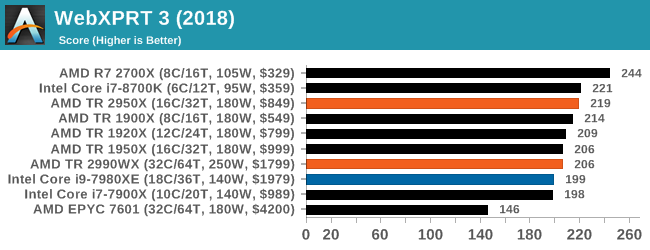
WebXPRT 2015: HTML5 and Javascript Web UX Testing
The older version of WebXPRT is the 2015 edition, which focuses on a slightly different set of web technologies and frameworks that are in use today. This is still a relevant test, especially for users interacting with not-the-latest web applications in the market, of which there are a lot. Web framework development is often very quick but with high turnover, meaning that frameworks are quickly developed, built-upon, used, and then developers move on to the next, and adjusting an application to a new framework is a difficult arduious task, especially with rapid development cycles. This leaves a lot of applications as ‘fixed-in-time’, and relevant to user experience for many years.
Similar to WebXPRT3, the main benchmark is a sectional run repeated seven times, with a final score. We repeat the whole thing four times, and average those final scores.
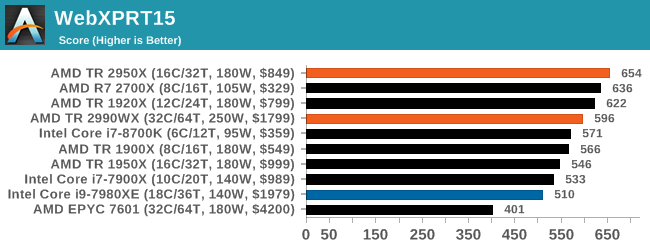
Speedometer 2: Javascript Frameworks
Our newest web test is Speedometer 2, which is a accrued test over a series of javascript frameworks to do three simple things: built a list, enable each item in the list, and remove the list. All the frameworks implement the same visual cues, but obviously apply them from different coding angles.
Our test goes through the list of frameworks, and produces a final score indicative of ‘rpm’, one of the benchmarks internal metrics. We report this final score.
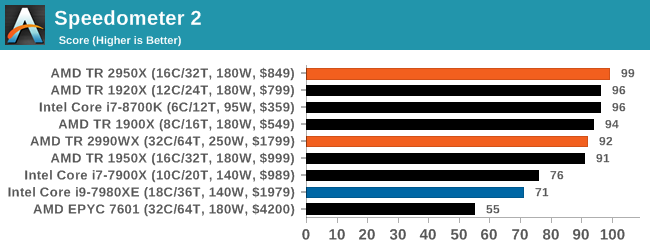
Google Octane 2.0: Core Web Compute
A popular web test for several years, but now no longer being updated, is Octane, developed by Google. Version 2.0 of the test performs the best part of two-dozen compute related tasks, such as regular expressions, cryptography, ray tracing, emulation, and Navier-Stokes physics calculations.
The test gives each sub-test a score and produces a geometric mean of the set as a final result. We run the full benchmark four times, and average the final results.

Mozilla Kraken 1.1: Core Web Compute
Even older than Octane is Kraken, this time developed by Mozilla. This is an older test that does similar computational mechanics, such as audio processing or image filtering. Kraken seems to produce a highly variable result depending on the browser version, as it is a test that is keenly optimized for.
The main benchmark runs through each of the sub-tests ten times and produces an average time to completion for each loop, given in milliseconds. We run the full benchmark four times and take an average of the time taken.
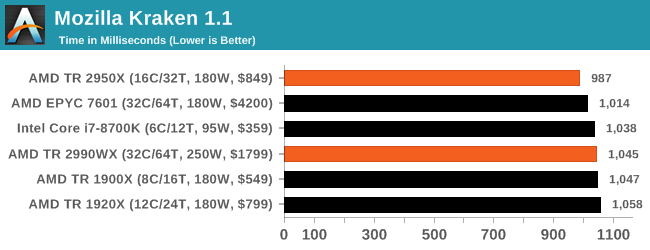
3DPM v1: Naïve Code Variant of 3DPM v2.1
The first legacy test in the suite is the first version of our 3DPM benchmark. This is the ultimate naïve version of the code, as if it was written by scientist with no knowledge of how computer hardware, compilers, or optimization works (which in fact, it was at the start). This represents a large body of scientific simulation out in the wild, where getting the answer is more important than it being fast (getting a result in 4 days is acceptable if it’s correct, rather than sending someone away for a year to learn to code and getting the result in 5 minutes).
In this version, the only real optimization was in the compiler flags (-O2, -fp:fast), compiling it in release mode, and enabling OpenMP in the main compute loops. The loops were not configured for function size, and one of the key slowdowns is false sharing in the cache. It also has long dependency chains based on the random number generation, which leads to relatively poor performance on specific compute microarchitectures.
3DPM v1 can be downloaded with our 3DPM v2 code here: 3DPMv2.1.rar (13.0 MB)

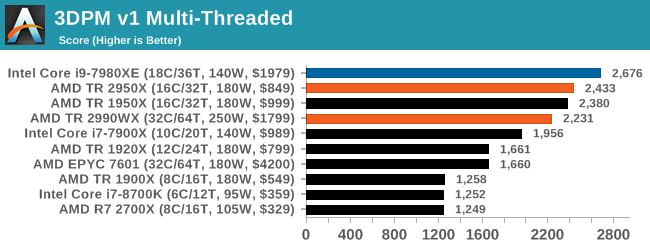
x264 HD 3.0: Older Transcode Test
This transcoding test is super old, and was used by Anand back in the day of Pentium 4 and Athlon II processors. Here a standardized 720p video is transcoded with a two-pass conversion, with the benchmark showing the frames-per-second of each pass. This benchmark is single-threaded, and between some micro-architectures we seem to actually hit an instructions-per-clock wall.
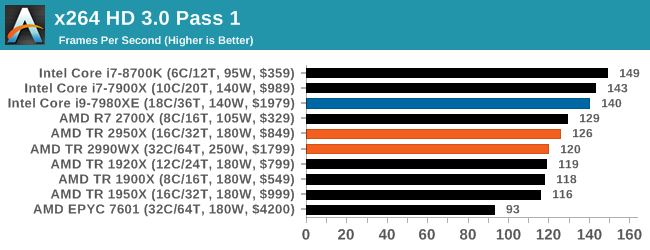
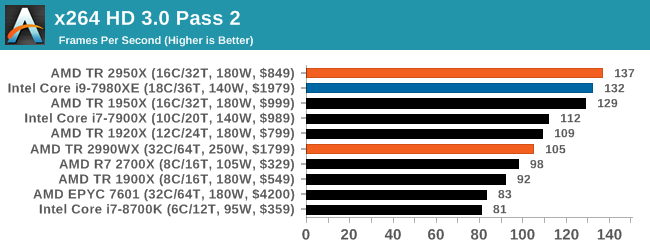










171 Comments
View All Comments
MattZN - Monday, August 20, 2018 - link
If its idling at 80-85W that implies you are running the memory fabric at 2800 or 3000MHz or higher. Try running the fabric at 2666MHz.Also keep in mind that a 2990WX running all 64 threads with a memory-heavy workload is almost guaranteed to be capped out by available memory bandwidth, so there's no point overclocking the CPU for those sorts of tests. In fact, you could try setting a lower PPT limit for the CPU core along with running the memory at 2666... you can probably chop 50-100W off the power consumption without changing the test results much (beyond the difference between 3000 and 2666).
It's a bit unclear what you are loading the threads with. A computation-intensive workload will not load down the fabric much, meaning power will shift to the CPU cores and away from the fabric. A memory-intensive workload, on the otherhand, will stall-out the CPU cores (due to hitting the memory bandwidth cap that 4 memory channels gives you), and yet run the fabric at full speed. This is probably why you are seeing the results you are seeing. The CPU cores are likely hitting so many stalls they might as well be running at 2.8GHz instead of 3.4GHz, so they won't be using nearly as much power as you might expect.
-Matt
XEDX - Monday, August 20, 2018 - link
What happened to the Chromium compile rate for the 7980XE? On it's own review posted on Sep 25th 2017, it achieved 36.35 compiles per day, but in this review it dropped all the way down to 21.1.jcc5169 - Saturday, August 25, 2018 - link
Intel Will Struggle For Years And AMD Will Reap The Benefits-- SegmentNext https://segmentnext.com/SWAPNALI - Tuesday, August 28, 2018 - link
nice place here thanks alot for this information please do more post here<a href="http://clash-of-royale.com/">play clash of royale</a>
Relic74 - Wednesday, August 29, 2018 - link
Regardless of the outcome, I went ahead and bought the 32 Core version. As I run SmartOS, an OS designed to run and manage Virtual Machines, I decided to go this route over the Epyc 24. My setup includes the new MSI MEG X399, 32 Core TR, 128GB DDR4 RAM, 3x Vega Frontier (used, $1000 for all three, no one wants them but I love them), 1 X Nvidia Titan Z (used for only $700, an amazing find from a pawn shop, did not know what he had, had it marked as an XP). Storage is 2 x 1TB Samsung 970 Pro in Raid 0 and 5x 8TB SATA in Raid 5 with 8GB of cache on card.The system is amazing and cost me much, much less than the iMac Pro I was about to buy. Now though, I can run any OS in VM, including OSX, with a designated GPU per VM and cores allocated to them. This setup is amazing, SmartOS is amazing, I have stopped running OS's with every application installed, Instead I create single purpose VM's and just install one or maybe two applications per. So for instance when I'm playing a game like DCS, a fantastic flight simulator, only has DCS and Steam installed on the VM. Allowing for the best performance possible, no, the lost of any performance by running things in VM are so minuscule that it's a none issue. DCS with the Titan V runs at over 200 FPS at 4K with everything turned to their max values. I have to actually cap games to my gaming monitors 144Hz refresh rate. Not only that but I can be playing the most demanding game their is, even in VR, while encoding a media file, while rendering something in Blender, while compiling an application, all tasks running under their own VM like a orchestra of perfection.
Seriously, I will never go back to a one OS at a time machine again, not when SmartOS exists and especially not when 32 Cores are available at your command. In fact, anyone who buys this CPU and just runs one single OS at a time is an idiot as you will never, ever harness it's full intention as no one single application really can at the moment or at least not to the point where it's worth doing it.
Most games dont need more than 4 cores, most design applications can't even use more than 2 cores, rendering applications use more of the GPU than CPU, in fact the only thing that really tasks my CPU is SmartOS that is controlling everything but even that doesn't need more than 6 cores to function perfectly, heck, I even had it at 12 cores but it didn't utilize it. So I have cores coming out of the yin-yang and more GPU's than I know what to do with. Aaaaahhhh poor, poor me.
This computer will be with me for at least 10 years without ever feeling that I need an upgrade, which is why I spent the money, get it right the first time and than leave it alone I say.
Oh and the memory management for SmartOS is incredible, I have set it up where if a VM needs more RAM, it will just grab it from another that isn't using it at the moment, it's all dynamic. Man, I am in love.
Anyway.....
Phaedra - Sunday, March 3, 2019 - link
Hi Relic74,I enjoyed reading your lengthy post on the technical marvel that is SmartOS and the 32 Core TR.
I am very much interested in the technical details of how you got SmartOS to work with AMD hardware. Which version of SmartOS, Windows, KVM (or BHYVE) with PCI passthrough etc?
I am in the process of preparing my own threadripper hyper computer and would love some advice regarding the KVM + PCI passthrough process.
You mention gaming in a VM so I assume that you used a Windows 10 guest via KVM with PCI passthrough?
The following says SmartOS doesn't support KVM on AMD hardware: https://wiki.smartos.org/display/DOC/SmartOS+Techn...
Did you build the special module with amd-kvm support:
https://github.com/jclulow/illumos-kvm/tree/pre-ep...
or
https://github.com/arekinath/smartos-live
I would appreciate any insight or links to documentation you could provide. I am familiar with Windows/Linux/BSD so you can let me have the nitty-gritty details, thanks
gbolcer - Wednesday, September 19, 2018 - link
Curious why virtualization disabled?Ozymankos - Sunday, January 27, 2019 - link
Your tests are typical for a single core machine which is laughableplease try to download a game with steam,play some music,watch tv on a tvtuner card,play a game on 6 monitors or 8 or 4 ,do some work like computing something in the background(not virus scanners,something intelligent like life on other planets)
then you shall see the truth
intel352 - Thursday, July 18, 2019 - link
Old article obviously, but wth, numerous benchmark graphics are excluding 2950x in the results. Pretty bad quality control.EthanWalker28 - Monday, February 24, 2020 - link
If you are looking for custom writing firm to help you out with your academic writing issues, then you have just found the right one. Now, you don’t have to worry about getting a failing mark simply because you have been accused of plagiarizing someone else’s work. Check this <a href="https://ewriters.pro/" rel="nofollow">ewriters.pro</a> Order essay online staying 100% safe and confidential.